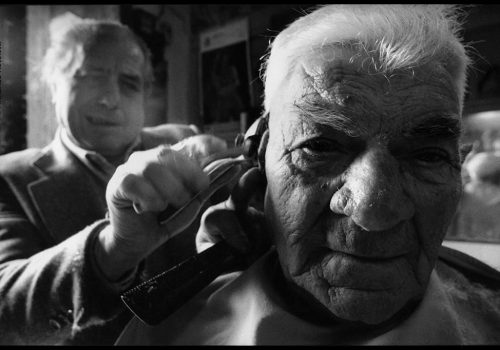Would you know better Sicily’s smaller towns of the ‘90s, you should take a look at Barbers of Sicily by Armando Rotoletti. Both the exhibition at Palazzo Beneventano in Lentini, near Syracuse, and the book (same title) are a precious work witnessing traditions and jobs which have now almost completely disappeared. Indeed, it’s not only a reportage, but it stands somewhere between photo journalism and anthropological research and according to this idea, L’Oeil de la Photographie interviewed Rotoletti.
How and why did you conceive the Barbers of Sicily project?
This work is the product of a research, carried out almost thirty years ago, dealing with the last barber shops still unaffected by the modernisation process altering the island. In the early nineties I was in Sicily on behalf of a national newspaper, covering a story about the towns that had been the birthplace of Mafia. While I was in Corleone, I walked by chance into an old barber shop and I was struck by a revelation. Before my eyes was the most authentic setting of Sicilian sociability, a veritable sociability of yore. I suddenly knew an era was about to disappear. I had the idea of fixing time on film, catching that intangible trace of traditional Sicilian essence which I knew very well, being Sicilian myself, before it was too late. So, over the next three years I was back in Sicily looking for these special places. Vincenzo Consolo and Igor Man, two eminent authors from Sicily’s good old days, inspired me in this project.
You portrayed the shops, but especially the barbers. How did they agreed to your request?
The exciting thing was it seemed they were there waiting for me. You can feel it looking at their gaze. They were waiting for someone documenting them, their work, their shops, the culture to which they belonged.
Why this exhibition can still be considered relevant, despite it portrays an already vanishing reality?
It’s a world that doesn’t exist anymore, not even in the most inland villages. And this work tells about the barbers, but also of our origins, of who we were and of our heritage. I think it is going to be an increasingly topical issue.
The barber’s was an especially important place for the town. Why?
In Sicily’s smaller towns the barber’s was a kind of “indoor square” where all the life of the main square flow to. People from all social classes would meet here and hang out: sports events, local gossips and all the drama affecting the community would be commented upon. I think the barber’s was an ante-litteram facebook. On my childhood memory, the barber’s was a sort of secular church, where so many things were carried on. U masru (the barber) used to be a patient man, respected by all: his role in the community would become that of a keeper of all sorts of news. These shops were extremely vital centers, they were the epicenter of popular culture, playing a pivotal role in oral tradition and visual communication, but they were also “exhibition centres” for a varied iconography of contemporary heroes and idols, a melting pot of sacred and profane: show biz stars, famous footballers, but also the “Good Pope”, would inspire the customers’ conversation. And custumers for a few minutes became part of such an idealized world. Although their interiors were austere, with minimalistic furniture, the radio was never missing in these shops. As well as human contact and social interaction. They were a stage for musical interludes, for wedding arrangements, real estate sales, too. The more sophisticated ones even held literary and poetry readings. Nowadays many things have changed, starting from the great improvement in sanitation with a more specialized professionalism, but now they are “neutral” places, they are no more icons.
The exhibition was hosted at Palazzo Beneventano (an extremely interesting building that belonged to the Baron Beneventano) in Lentini, near Syracusae. The venue is now open thanks to Italia Nostra and, as a significant cultural hub, it welcomes visitors to its fifty frescoed rooms – including the throne and the music ones – and to a number of cultural events.
Paola Sammartano
Paola Sammartano is a journalist, specialized in arts and photography, based in Milan.
Barbieri di Sicilia
Until October 6, 2019
Palazzo Beneventano
via San Francesco d’Assisi 4 – Lentini (SR)
www.facebook.com/pg/PalazzoBeneventanoLentini
















